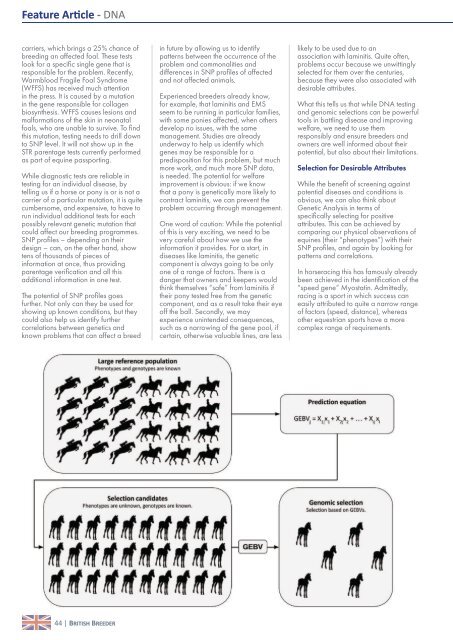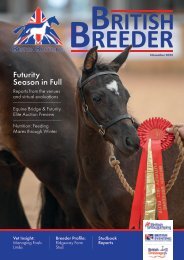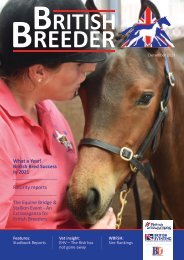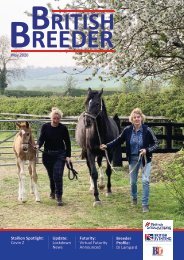British Breeder Magazine May 2021
You also want an ePaper? Increase the reach of your titles
YUMPU automatically turns print PDFs into web optimized ePapers that Google loves.
Feature Article - DNA<br />
carriers, which brings a 25% chance of<br />
breeding an affected foal. These tests<br />
look for a specific single gene that is<br />
responsible for the problem. Recently,<br />
Warmblood Fragile Foal Syndrome<br />
(WFFS) has received much attention<br />
in the press. It is caused by a mutation<br />
in the gene responsible for collagen<br />
biosynthesis. WFFS causes lesions and<br />
malformations of the skin in neonatal<br />
foals, who are unable to survive. To find<br />
this mutation, testing needs to drill down<br />
to SNP level. It will not show up in the<br />
STR parentage tests currently performed<br />
as part of equine passporting.<br />
While diagnostic tests are reliable in<br />
testing for an individual disease, by<br />
telling us if a horse or pony is or is not a<br />
carrier of a particular mutation, it is quite<br />
cumbersome, and expensive, to have to<br />
run individual additional tests for each<br />
possibly relevant genetic mutation that<br />
could affect our breeding programmes.<br />
SNP profiles – depending on their<br />
design – can, on the other hand, show<br />
tens of thousands of pieces of<br />
information at once, thus providing<br />
parentage verification and all this<br />
additional information in one test.<br />
The potential of SNP profiles goes<br />
further. Not only can they be used for<br />
showing up known conditions, but they<br />
could also help us identify further<br />
correlations between genetics and<br />
known problems that can affect a breed<br />
in future by allowing us to identify<br />
patterns between the occurrence of the<br />
problem and commonalities and<br />
differences in SNP profiles of affected<br />
and not affected animals.<br />
Experienced breeders already know,<br />
for example, that laminitis and EMS<br />
seem to be running in particular families,<br />
with some ponies affected, when others<br />
develop no issues, with the same<br />
management. Studies are already<br />
underway to help us identify which<br />
genes may be responsible for a<br />
predisposition for this problem, but much<br />
more work, and much more SNP data,<br />
is needed. The potential for welfare<br />
improvement is obvious: if we know<br />
that a pony is genetically more likely to<br />
contract laminitis, we can prevent the<br />
problem occurring through management.<br />
One word of caution: While the potential<br />
of this is very exciting, we need to be<br />
very careful about how we use the<br />
information it provides. For a start, in<br />
diseases like laminitis, the genetic<br />
component is always going to be only<br />
one of a range of factors. There is a<br />
danger that owners and keepers would<br />
think themselves “safe” from laminitis if<br />
their pony tested free from the genetic<br />
component, and as a result take their eye<br />
off the ball. Secondly, we may<br />
experience unintended consequences,<br />
such as a narrowing of the gene pool, if<br />
certain, otherwise valuable lines, are less<br />
likely to be used due to an<br />
association with laminitis. Quite often,<br />
problems occur because we unwittingly<br />
selected for them over the centuries,<br />
because they were also associated with<br />
desirable attributes.<br />
What this tells us that while DNA testing<br />
and genomic selections can be powerful<br />
tools in battling disease and improving<br />
welfare, we need to use them<br />
responsibly and ensure breeders and<br />
owners are well informed about their<br />
potential, but also about their limitations.<br />
Selection for Desirable Attributes<br />
While the benefit of screening against<br />
potential diseases and conditions is<br />
obvious, we can also think about<br />
Genetic Analysis in terms of<br />
specifically selecting for positive<br />
attributes. This can be achieved by<br />
comparing our physical observations of<br />
equines (their “phenotypes”) with their<br />
SNP profiles, and again by looking for<br />
patterns and correlations.<br />
In horseracing this has famously already<br />
been achieved in the identification of the<br />
“speed gene” Myostatin. Admittedly,<br />
racing is a sport in which success can<br />
easily attributed to quite a narrow range<br />
of factors (speed, distance), whereas<br />
other equestrian sports have a more<br />
complex range of requirements.<br />
44 | BRITISH BREEDER















